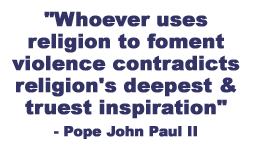MIRACLE AT ASSISI
World religions praying for peace
By Fr. Damian MacPherson, SA
September 2002
Return to Table of Contents
Print Article
In 1986, when nuclear tensions were at a height, Pope John Paul II invited leaders of the world's religions to Assisi, Italy, to pray for world peace. This event is perhaps history's most important multifaith prayer service. It is also one of the largest gatherings of religious leaders in world history. The 1986 gathering triggered interfaith activity all over the world. Each year, on the feast of St. Francis, Catholics join with other faiths to pray for peace.
The Assisi event was repeated and surpassed on January 24, 2002, when Pope John Paul, in the shadow of September 11, invited more than 200 religious leaders to Assisi to pray for a world in crisis. The Pope was intent on demonstrating that religion needs to be an agent for peace and not a rationale for terrorism, violence and hatred.
The following reflection on Assisi 2002, authored by Fr. Damian MacPherson, is reprinted with the permission of The Catholic Register. Fr. Damian is director of ecumenical and interfaith affairs for the Archdiocese of Toronto. He is also a member of the Franciscan Friars of the Atonement, a religious order founded to promote ecumenical and inter-religious cooperation.
The remarkable success of Assisi 2002 remains fresh in the memory of most who took note of that event. I think many-Roman Catholics especially-would agree that it is just downright difficult to anticipate what Pope John Paul's next historical initiative will be,  given his known passion for Christian unity and his dedicated efforts to interfaith dialogue.
given his known passion for Christian unity and his dedicated efforts to interfaith dialogue.
In view of his alphabet of historical firsts, one has to wonder if he has not left a wrinkle of concern in the brows of some in his College of Cardinals, as he places the footprints of the Roman Catholic Church on uncharted territory in the interreligious world.
I would like to suggest another first that possibly is being overlooked. I refer to Pope John Paul's exercise of a new form of leadership in his invitation to the world religious leaders to Assisi to pray for world peace.
The recent gathering of religious leaders was one of the largest and most representative gatherings ever assembled. Response to John Paul's invitation came from 16 churches and ecclesial communities, 30 Muslim clerics from 18 nations, 10 rabbis, and representatives from Buddhism, Tenrikyo, Shintoism, Jainism, Sikhism, Hinduism, Zoroastrianism, Confucianism and traditional African religions. In addition, from those religious leaders not represented, there was no known voice of dissent and thus one could only assume agreement with the proceedings.
Without question, gathered there on January 24 in that small town of Assisi was the spoken voice of the world religions. It is not an experience likely to have a repetitious future. The unified response and enthusiastic presence of these representatives to the invitation of John Paul II can be seen as an exercise of a new form of leadership on the part of the Pope.
Clearly, he is respected as the first moral voice of authority in the world today, particularly on issues of international concern for world peace and justice. Addressing the interreligious assembly in Assisi, the Holy Father spoke the minds of all those gathered when he affirmed that "whoever uses religion to foment violence contradicts religion's deepest and truest inspiration."
This new and perhaps unusual expression of leadership on the part of Pope John Paul was fully embraced by Rabbi Israel Singer, secretary of the World Jewish Congress. Rabbi Singer, departing from his prepared text addressed to the Holy Father and the assembled world religious representatives, stated more than once, "only you (Pope John Paul) could make this happen." Few would question that Rabbi Singer was not at the same time echoing the full sentiments of all who had gathered.
This affirmation of Pope John Paul's leadership, from his elder brother in religion, could not have been more affirming for the world at large. Religion will be around for as long as civilization survives. Therefore, capturing the strength and meaning of the events of Assisi 2002 remains an enduring religious legacy.
While world religious leaders were gathering in Assisi, interfaith communities around the world were also assembling. If the six multifaith celebrations in the Archdiocese of Toronto were representative of what happened elsewhere, it is clear that the laity, who responded far beyond expectation, feel the urgency to be connected around values that are common to our various beliefs.
Return to Table of Contents
Print Article